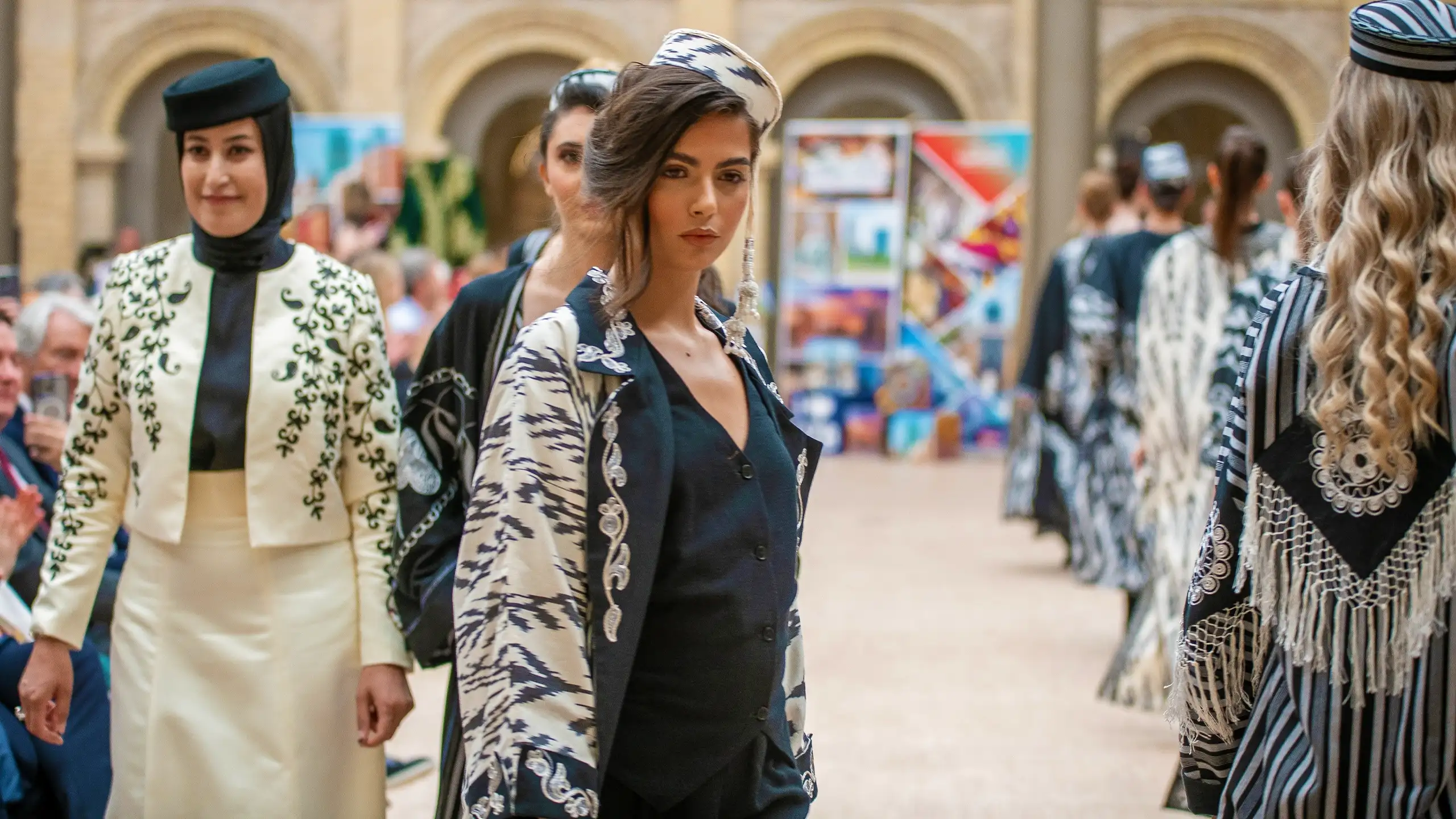

Editor-In-Chief
MeeKar Lim
International Fashion Editor
Suna Moya
Editor-At-Large
Zhang XiaoXiao

Please contact:
media-works@qcegmag.com
or
WeChat:QCEGMAG_Contact
QCEG MAG is a publication covering a selection of news in fashion, beauty, accessories, celebrities, LIVING ARTS, sports TRAVELS and relating videos around the world. Our portal is currently available in English and Chinese Languages for our international readers & viewers.
Get to know our professional team and their passionate creativity at QCEGPro.com



“Dilafruz presents timeless Uzbek heritage at Les Franciscaines, where art, fashion and storytelling meet in Deauville.”

At Les Franciscaines in Deauville, fashion became a living canvas — where heritage, art, and storytelling converged in a dialogue of cultures. The museum was transformed into a stage of creativity and emotion, curated by Tatiana Lebedeva and Philippe Jurkowicz, and featuring designers from Kazakhstan and beyond.
Among the highlights was the fashion house Dilafruz, whose vision is steeped in heritage, history, and deeply personal muses. The house was born in the historic city of Shakhrisabz, Uzbekistan—the birthplace of Timur and home to Timurid architectural wonders. For Dilafruz, art and craftsmanship are inseparable. Handmade carpets and suzani—richly embroidered textiles handed down through generations—are not simply inspirations but living legacies.
Rooted in tradition yet transcending borders, Dilafruz creates garments that are both narratives and artefacts. Each piece is a dialogue between history, personal memory, and timeless artistry. While Shakhrisabz remains the foundation of the brand, its ambition is universal: to connect, inspire, and evolve.
Following her presentations in Paris and Deauville, we spoke with Dilafruz Rustamovna about the inspirations, fabrics and techniques that shaped her latest collection — a study in heritage, craft and contemporary wearability.
— SUNA MOYA
DILAFRUZ
“Dilafruz presents timeless Uzbek heritage at Les Franciscaines, where art, fashion and storytelling meet in Deauville.”

QCEG : What inspired your latest collection, presented in Paris and Deauville? What fabrics and techniques did you use?
Dilafruz Rustamovna: My collection is conceived entirely in black and white — timeless hues that shift depending on how they are worn. In Shakhrisabz, aesthetic preferences were historically shaped by the city’s elite. Grand, ornate garments, often richly embroidered, were traditionally made for nobility. This creative code — large chapans, suzani and robes — forms the foundation of my collection.
I drew inspiration from the Shakhrisabz school of embroidery, particularly its broad three-banded borders and motifs such as four lamps and flowering bushes. Each element was chosen with care to create a cohesive visual identity. All textiles are handwoven with silk threads and traditional stitching techniques. In Uzbekistan, suzani — the handwoven textiles passed down in a bride’s trousseau — remain a living tradition. Creating fabrics designed to endure for a century is, to me, true artistry.
The black-and-white palette makes a bold statement whilst remaining universally wearable. Large, flowing silhouettes — captured perfectly by the French word allure — express the stride, grace and magnetic presence of a woman draped in one of my chapans, the traditional robes renowned for their elegance and fluidity.
QCEG : How do you balance traditional Uzbek craftsmanship with contemporary fashion?
Dilafruz Rustamovna: In Shakhrisabz, clothing has always been both functional and beautiful. This gave me, from an early age, the understanding that fashion must live within the rhythms of real life.
Today, individuality and natural fabrics are highly prized. Modern clients curate their own image, which allows bold, original pieces to exist alongside garments adapted to everyday urban life — such as cropped, chapan-inspired cardigans. At Dilafruz, our haute gamme collections are crafted from handwoven textiles, transforming each garment into a collectible piece.
QCEG : You’ve mentioned that the women in your family are your muses. How does this influence appear in your work?
Dilafruz Rustamovna:The women in my family — my great-grandmother, my grandmothers and my mother — embody grace, strength and resilience. Their influence is intrinsic, woven into my very being like the seasons of my hometown. It manifests in my silhouettes, my embroidery, and the quiet narratives embedded in each piece — a tribute to their lives and their legacy.
QCEG : Suzani is central to your work. Can you explain its symbolism and your approach to reviving it?
Dilafruz Rustamovna:Suzani is storytelling in thread. Traditionally, symbols of the sun, moon and planets are embroidered into wedding textiles, with small gaps intentionally left for future generations to continue the work. I honour this practice by blending history with contemporary fashion so that it may live, evolve and speak to the 21st century.
QCEG : Do you find inspiration in other contemporary designers?
Dilafruz Rustamovna: Absolutely. Designers such as Madina Kasymbaeva inspire me; she too revives traditional art for modern audiences. We share the belief that heritage is alive — it must breathe, transform and inspire future generations.
QCEG : How was your experience on the international fashion stage in Paris and Deauville?
Dilafruz Rustamovna: Paris and Deauville are legendary platforms for global fashion. I could feel how deeply my inspirations — rooted in my brand’s “made in” identity — resonated with French experts and international audiences alike. Large chapans, alongside their shorter, more versatile counterparts, provide endless styling possibilities. Each silhouette, each gesture, carries a historical narrative — values that intrigue and connect across cultures.
QCEG : What was the reaction of the international audience, and how did it feel to share Uzbek heritage on such prestigious stages?
Dilafruz Rustamovna: Deauville, especially Les Franciscaines, left an indelible impression on me. The Art-Storytelling programme gathered designers from across the globe to share their visions. Deauville itself — where Chanel opened her first boutique and discovered her love for beige, inspired by the sand, sea and sky — was the perfect setting. I was deeply moved by how warmly the audience embraced our heritage, recognising history, craftsmanship and storytelling in every piece.
QCEG : What message would you like to share with the public?
Dilafruz Rustamovna: For me, design is about authenticity — honouring what has been entrusted to me by my surroundings, traditions and heritage. The world moves quickly, yet I strive to let each collection unfold at its own rhythm, without haste.
Every collection continues the narrative of the one before, each a thread in a larger tapestry. My ambition is to remain ahead of time: to create trends rather than follow them, while never forgetting where my journey began.
